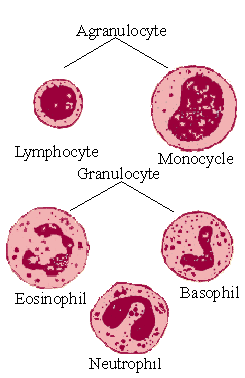|
PinkMonkey Online Study Guide-Biology
Functions of Red Blood Cells (RBC)
(i) To carry oxygen in the form of oxyhemoglobin
from the respiratory organs to all cells of the body.
(ii) To carry carbon dioxide in the form of
potassium bicarbonate from the tissue cells to the respiratory
organs.
(2) Leucocytes or white blood corpuscles

Fig. 18.10 Types of Leucocytes
White blood corpuscles are less numerous, about
seven thousand per cubic millimeter of blood, i.e. the ratio of
RBCs to WBC (White Blood Cells) is about 600:1. They are colorless,
nucleated and migrate anywhere in the body. Leucocytes are produced
in spleen or yellow bone marrow and when worn out, they are degraded
in the blood stream and engulfed by other phagocytes. Some leucocytes
are also destroyed by microorganisms at the site of invasion (infection).
These destroyed leucocytes, along with damaged tissue cells with
some plasma, form a yellowish liquid called pus, causing
inflammation or abscess. During infection the number of leucocytes
in blood increases.
A chronic abnormal increase in leucocytes can lead
to leukemia or blood cancer inhibiting the normal production of
RBCs.
Functions of leucocytes: (i) They are mainly
phagocytic in function ingesting bacteria, cell debris and other
injurious materials occurring in blood.
(ii) They produce antibodies and antitoxins which
are specific in action.
[next page]
|